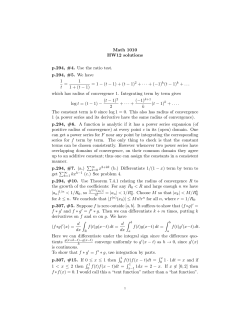
MAS004 Sheet 20: Surfaces of revolution
MAS004 Sheet 20: Surfaces of revolution Friday, 15th May Notes in brief It is important to be able to calculate the volumes of shapes, and better to have good techniques than to memorise many formulae. Here are some. Volumes of surfaces of revolution There are many shapes that can be thought of as surfaces of revolution, the shape made by rotating a curve. Cones and spheres have this feature, but machinists make many more using lathes. Since they can be regarded as made of small circular slices, their area can be calculated by integration: if f (x) is the radius of a cross-section, the volume R is π f (x)2 dx. Cones One special case is that of a cone. Let’s consider a cone with height h and base radius r. r x=0 x=h We let x vary from x = 0 at the apex of the cone, to x = h at the base. When x = 0 the radius of the cross-section is zero, and when x = h the radius is r. Since the radius varies linearly, the radius at x is xr h . Hence to find the volume of the cone we integrate as follows: Z π 0 h xr 2 h dx = πr2 h2 h Z x2 dx = 0 1 πr2 h3 πr2 h = . 2 h 3 3 Exercises Exercise 1. (a) What’s the volume of a cone of height 3 and base radius 2? (b) What’s the volume of a cone of height 4 and base diameter 3? (c) What’s the volume of a cone of height 12 and slant height 13? (d) What’s the volume of a cone of base circumference 6 and height 4? Exercise 2. A component is machined with a√lathe. It is 10 cm high, and at height x cm the cross-section is a circle of radius x cm. Find the volume of the component in cm3 . Exercise 3. Consider a spherical container of radius 1. The z-coordinate runs from −1 to 1, and for each √ value the cross-section is a circle, which by Pythagoras’s theorem has radius 1 − z 2 . If the container is filled with liquid from the bottom (z = −1) up to z = a, what is the volume of the liquid? Exercise 4. The Great Pyramid at Giza has a square base which is 230 m on a side, and is about 140 m tall. Hence if you take a horizontal cross-section x metres from 23 the top, the cross-section is a square of side length 14 m. Integrate to find the volume of the Great Pyramid. Rather harder: find the total area of the four sloping sides. Solutions Solution 1. (a) 4π, (b) 3π, (c) 100π, (d) 12/π. Solution 2. The relevant integral is π R 10 √ 2 R 10 ( x) dx = π 0 xdx = 50π. 0 2 Solution 3. Integrating gives us Z a π a z3 (1 − z )dz = π z − 3 −1 −1 3 a (−1)3 a3 2 =π a− − (−1) − =π a− + . 3 3 3 3 Z p ( 1 − z 2 )2 dz = π −1 a 2 Solution 4. The volume is given by the integral, taken over the height, of the area of the cross-sections. This is given in cubic metres by Z 0 140 23 x 14 2 dx = 23 14 2 Z 140 x2 dx = 0 23 14 2 x3 3 140 0 232 1403 232 × 14000 7406000 = 2 = = . 14 3 3 3 As for the surface √ area, the distance from a corner of the base to the centre of the base is 70 2 m. Hence the length of the sloping edges can be calculated from this distance and the height by Pythagoras’s theorem to be 171.46 m. Now, half the length of a side is 115 m. Hence, by Pythagoras again, the left-hand half of a side is a triangle of base 115 m and height calculated using Pythagoras to be 127.18 m. This means it has area 7312.91 m2 . A full face hence has area 14625.81 m2 , and all four together have area 58503.25 m2 . 3
© Copyright 2025














